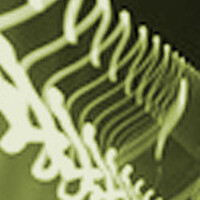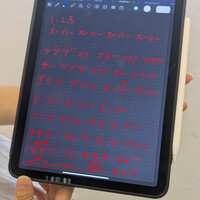From improvisation with restriction to detailed composition
Blog post
I observed the warm-up led by Nguyen Ngoc Anh, a choreographer based in Hong Kong. He led a series of improvisation-based tasks exploring how dancers can move while keeping some of their limbs extended. The focus was on keeping some of the elbow and knee joints “locked”, while still exploring locomotion and what mobility and fluidity there is to be found in the spine, wrist, shoulder, hip and ankle joints. Anh encouraged the dancers to play with asymmetry, for example keeping one arm by the side of the torso and playing with a sense of hiding and revealing the limbs one by one. Opposition became an important principle for movement. The extremities of each limb, for example a flexed foot on a straight leg, traced circles or figures of eight of different sizes, leading to an interplay of small detail and large projected movements. Anh invited the dancers to explore pauses, momentum and suspension to create rhythm in their movement phrasing.
The exercises illustrated an interesting example of choreographic restriction: by making a simple choice of removing mobility in the elbow and knee joints and exploring the range of movements that they can still access, the dancers created a unique and distinctive movement language. This led to a further exploration of duet work, this time with three limbs “locked” and the choice of one limb that is left “unlocked” to give greater freedom of motion. In this composition task, one pair of dancers discovered that it is very difficult to get up from sitting on the floor with two “locked” legs, to hilarious effect! A quick flip onto their front and sending the pelvis into the air while the hands walked backwards to their feet offered the best solution.

Speaking briefly to Anh during the rehearsal, he commented that his desire to explore this distinctive movement language with the dancers stemmed from his observation that contemporary dancers across the world tend to improvise in quite a homogeneous, fluid movement language based on isolation of different body parts. By creating this restriction, which they have been working with for one week and two days now since the start of the project, Anh aims to enable the dancers to create a new movement habit, which they can add to their toolbelt as professional dancers. In essence, this is a pedagogical approach to the ArtsCross opportunity aiming to equip dancers with new tools.
The improvisation tasks the dancers are faced with force them to learn to adapt to each new situation. Anh also talked about appreciating more what is there when they eventually go back to moving without the restriction. He talked about deciding how you save and spend what you have, about hiding and revealing, hinting at a transactional relationship between the improvising dancer and the spectator. He also takes a cinematographic approach to dance improvisation: what he wishes for the dancers to develop is the skill to direct the audience’s focus. By playing with the contrast of large movement and small detail in different parts of the body, dancers can draw the spectator’s eyes to a particular body part and then back onto the totality of the moving body. Anh talks about zooming in and out. In this way, dancers learn to create and sustain visual interest for an audience, playing with an element of surprise.
I spent the second part of the morning in the studio with Alethia Antonia, representing The Place in London, who after a full week of improvisation is now moving into precise composition. She talks about the privilege of being able to work out a vision with dancers in the studio as opposed to working out choreography in her head. The movement material is somewhat restrained rather than expansive; the movements of the limbs tend to be quite gestural and close to the body, which shifts weight and travels through space on the feet with soft knees. The kinesphere is small, intimate and introverted.
A recurring gesture is a slight and dainty waving of the fingers of the right hand by the left shoulder, with the torso and head twisted away to the left. This intricate play of postures and gestures points towards the contrast of letting the movements of the limbs emerge from the shifts of weight generated by the pelvis – movements emerging from the spine – versus the extremities initiating the movement and letting this trickle back into the centre, back into the spine.

Music and rhythm are a key compositional principle in Alethia’s choreographic process here, in dialogue with the hip hop track DNA by Kendrick Lamar. Melody is also a key element; when Alethia guides the dancers, she often sings parts of the melodies. The dancers lock their pauses in the movement phrases accentuating beats in the music.
There is a playing with falling in and out of unison. The ensemble element, the collective is a key anchor. The dancers start the sequence I witnessed in a tight huddle and move through this huddle with small foot shuffles and improvised torso and arm movements. They spread out slightly after this, while the close group formation functions a bit like a magnet; dancers might leave the group formation but always eventually slot back in. Alethia finds variation in the group unison by asking smaller groups of dancers to pause and resume the phrase at different moments, at times creating a brief sense of canon. There is a sense of smaller groups fading in and out of unison, then blending back in with the group. During a rare moment of only a duet being left in the dance space, the dancers use a call and response structure, facing each other.
I am thinking about what this emphasis on the ensemble and closeness of the group means for the larger meanings that are constructed through this choreography. In terms of what it means to be human in this current moment, togetherness seems like a very important element in Alethia’s world she is creating here. Even if there is room for individuality and for shared experiences in pairs or smaller groups, the power of the whole group, of unison and of moving in dialogue with the beats of the music are a key image in this process.
Posted by

Lise Uytterhoeven

